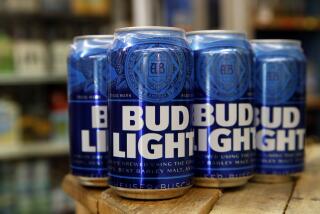Red Bull’s Buzz Rides Tech Bust
- Share via
After a 72-hour programming binge, Derek Fugasu and his team of software developers had hit a wall. They had to deliver a working model of a hopelessly botched e-commerce engine in 16 hours, and some team members were beginning to babble.
At 4 a.m., long after the Santa Monica bars once favored by upscale Internet workers have locked up, Fugasu dragged himself down the street into the shock-white lighting of an all-night 7-Eleven.
“Gimme all your Red Bull,” he said to the clerk, handing over nearly $150 in cash for three cases of the soda. “I need all of it.”
Fugasu slammed back a can at the cash register while waiting for change. Back in the office, his team immediately shredded the cases and started guzzling the yellow elixir--a beverage they believe is so packed with caffeine and “other stuff” that they were ready to go another three days straight, no problem.
If Mountain Dew is the drink of geeks and Gatorade the elixir of athletes, then Red Bull has emerged as the beverage of choice for dot-commers fighting for survival.
Hype and Internet rumor have spawned a belief that this pricey Austrian soda of Thai origin is a stimulant more powerful than coffee, more intense than speed, a legalized form of cocaine that draws its strength from a mysterious ingredient--one that fans swear (incorrectly) is testosterone drawn from bull semen.
This is the stuff for staying energized in an economy that is slowly slipping into a coma, a drink so power-packed that it’s been banned in high schools and even glows in the dark.
At least that’s the buzz.
“When you’re under deadline and you have to write several hundred descriptions of products we’re selling on the Web site, you need an extra kick,” said David Hunter, 36, a producer who used to work for financially troubled Express.com, an online entertainment and electronics shop.
In his office earlier this year, 10 dozen Red Bull cans filled up the windows of his cubicle, providing an aluminum wall of privacy. “I need energy, and I need it now,” Hunter said. “I can’t slam back a cup of coffee. It’ll burn my tongue.”
But like a lightly carbonated version of the “new economy” itself, the drink--the first and still most popular of the new energy drinks--is actually more fizz than juice.
The odd thing about this latest high-tech craze is the fact that Red Bull, with 80 milligrams of caffeine per can, doesn’t even have the caffeinated punch of a small Starbucks coffee, which can have more than 200 milligrams.
Oh sure, it has a stronger chemical punch than a can of Coca-Cola. But Red Bull’s caffeine level falls short of a double scoop of Ben & Jerry’s Coffee Heath-Bar Crunch ice cream. There’s nearly twice as much in a couple of Excedrin Extra Strength tablets--130 milligrams--and those will fix a headache at the same time.
As for the vaunted power of its special ingredients--inositol and taurine--researchers dismiss them as just marketing gimmicks.
Taurine, said Martha Stipanuk, professor of nutritional sciences at Cornell University, is a naturally occurring amino acid that is “very common in animal foods, such as meat and eggs, and in the milk of lactating women.”
“There is no evidence that humans, even vegans, are lacking in taurine,” she said. “It’s mainly the caffeine that has the effect.”
Red Bull’s adherents, however, are too busy fighting for their jobs to consider such scientific sour grapes. Deadlines are approaching. Dot-coms are crashing everywhere. Web programmers are heading back to Kansas in droves and filing for unemployment.
After littering the room with empty Red Bull cans, Fugasu and his programmers threw themselves back into their task.
As the sun began to rise, a visitor to the office told Fugasu the sobering truth about Red Bull: Coffee has more caffeine.
Facing the prospect of 12 more hours of grueling work fueled only by some watered-down caffeine supplement, Fugasu was at first stunned, then shattered. As the truth sank in, he begged to keep his company anonymous and pleaded: “Don’t tell my team.”
Red Bull is the brainchild of Austrian entrepreneur Dietrich Mateschitz, who first tasted the drink in the early 1980s while traveling in Thailand.
In the Far East, the drink is known as Krating Daeng (red bull in Thai) and is one of many caffeine-laced “health tonics” that are sold in pharmacies and gas stations from Tokyo to Jakarta.
Mateschitz bought the non-Asian rights from the maker, TC Pharmaceuticals, and changed the formula to accommodate Western tastes.
The soda entered the U.S. market around 1997 with a savvy marketing campaign focused on immediacy that spoke loudly to the dot-com world, where workers had grown up in a culture of instant gratification and one-click answers.
“It gets lumped in with things like extreme sports and the X Games. It’s alternative--it’s not Coke or Pepsi,” said Hunter, formerly of Express.com. Red Bull now accounts for about 65% of the energy drink market, which pulled in $135 million wholesale in the United States last year, according to the Beverage Marketing Corp., an industry research and consulting firm based in New York.
Its success is still a mere drop in the 15-billion-gallon ocean of carbonated sugar water, which generated $60 billion in sales last year. And numerous competitors have popped up to capitalize on Red Bull’s “power” appeal, with such new entrants as Adrenaline Rush, Energy and Whoop Ass.
There also is some question as to the power of Red Bull’s allure. In Seattle, some Microsoft techies scoff at the Austrian drink, preferring a long chug of Whoop Ass.
“Red Bull is weak,” said James Allard, a general manager with Xbox, the Microsoft division that is building a video game console machine.
There also are signs that even vast quantities of caffeine and taurine cannot revive the flagging prospects of the new economy: Hunter found himself out of a job this year when Express.com filed for Chapter 11 bankruptcy protection. He now works for Red Bull.
Fugasu experienced a similar epiphany not long after his initial enlightenment about Red Bull. The company he worked for went bankrupt, and Fugasu and his team had to find new jobs.
Still, Red Bull remains the market--and hipness--leader. It is the Porsche of soft drinks. At local convenience stores, it often sells for $1.99 a can. At local nightclubs such as the Saddle Ranch in West Hollywood--where bartenders pour gallons of Red Bull and vodka, and mix everything from rum to champagne with the yellow drink, thirsty urban cowpokes happily fork out $4 just for the energy drink alone.
“It’s cheap here,” Claire McDonald, 24, an out-of-work Web designer and aspiring actress, said as she waited in line to ride the club’s mechanical bull. “Last month, I was over at the Hollywood Standard [Hotel], and they were charging $5 a can. And I spent $10 for a can in New York.”
What makes a soda worth $10 for a puny 8.3-ounce can?
“Check this out,” said Ryan Kull, an assistant producer for computer-game maker THQ Inc. “It glows in the dark.”
Kull cracked open an ice-cold can and poured the drink into a clear glass. Walking into a nearby office, he doused the overhead fluorescent lights and clicked on a black-light lamp.
The beverage, once the color of beer, turned a radioactive green.
“Cool, huh?” he said with a grin, tilting his head back to drain the glass in one gulp.
The staff at PhatNoise Inc., a Los Angeles based company that makes MP3 digital music players for cars, swears by the stuff--regardless of its chemistry. A large Red Bull sign glows from their Westside office windows, broadcasting the company’s love of the beverage to the pricey homes below.
“It works for us,” said Dannie Lau, chief executive of PhatNoise. “Besides, if it’s not that powerful, how come schools have banned it?”
That’s a question that Red Bull officials still can’t answer after an incident last fall at John Burroughs High School in Burbank.
Just before football practice one day in late October, Coach Marty Garrison watched as two sophomore players walked along the sidelines, sat down on a bench and began swaying.
“They were acting like they were on speed, and they had never, ever acted like that,” Garrison said. “They actually fell down from exhaustion.”
School officials investigated the matter and learned that they had consumed an energy drink. Within days, the school issued a letter to all parents, informing them that caffeinated energy drinks were now banned on campus.
Local print and television media picked up the story. Reporters singled out the one energy drink they were familiar with--Red Bull.
There was only one problem. “The boys didn’t drink Red Bull,” Garrison said. “They drank a couple cans of something called Speed Stack.”
Speed Stack, a Red Bull rival made by health-food company American Body Building, offers a lengthy, and alarming, list of warnings on its label: “In case of accidental overdose, contact a physician, emergency medical care facility or poison control center immediately.”
Although Red Bull said little about the rumors, the company did send staff to the school with literature on their drink and how it should be consumed: as with coffee, drink it in moderation.
“Really, with very few exceptions, there is no such thing as bad publicity,” said company spokeswoman Emmy Cortes. “There are all sorts of rumors about Red Bull. That’s part of the allure.”
(BEGIN TEXT OF INFOBOX / INFOGRAPHIC)
Stimulating
Caffeine content of selected products:
Red Bull: 80 milligrams per 8-ounce serving
Starbucks Coffee: 200 milligrams per 8-ounce serving on average
Mountain Dew: 37 milligrams per 8-ounce serving
Coca-Cola: 23 milligrams per 8-ounce serving
Excedrin Extra Strength: 65 milligrams per tablet
Source: Times research
More to Read
Inside the business of entertainment
The Wide Shot brings you news, analysis and insights on everything from streaming wars to production — and what it all means for the future.
You may occasionally receive promotional content from the Los Angeles Times.










